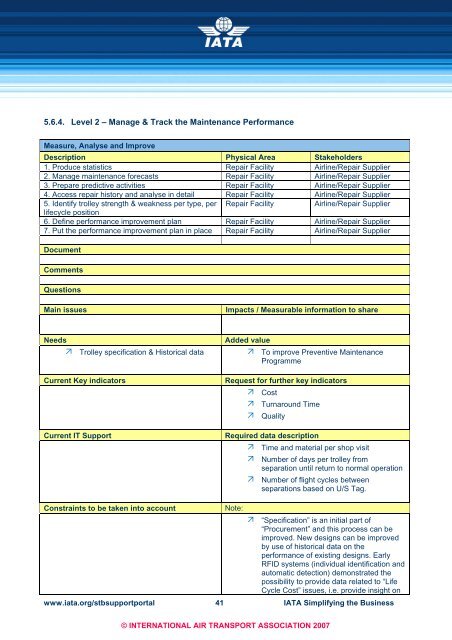INFLIGHT CATERING Process Analysis and User ... - IATA
INFLIGHT CATERING Process Analysis and User ... - IATA
INFLIGHT CATERING Process Analysis and User ... - IATA
Create successful ePaper yourself
Turn your PDF publications into a flip-book with our unique Google optimized e-Paper software.
5.6.4. Level 2 – Manage & Track the Maintenance Performance<br />
Measure, Analyse <strong>and</strong> Improve<br />
Description Physical Area Stakeholders<br />
1. Produce statistics Repair Facility Airline/Repair Supplier<br />
2. Manage maintenance forecasts Repair Facility Airline/Repair Supplier<br />
3. Prepare predictive activities Repair Facility Airline/Repair Supplier<br />
4. Access repair history <strong>and</strong> analyse in detail Repair Facility Airline/Repair Supplier<br />
5. Identify trolley strength & weakness per type, per Repair Facility Airline/Repair Supplier<br />
lifecycle position<br />
6. Define performance improvement plan Repair Facility Airline/Repair Supplier<br />
7. Put the performance improvement plan in place Repair Facility Airline/Repair Supplier<br />
Document<br />
Comments<br />
Questions<br />
Main issues Impacts / Measurable information to share<br />
Needs Added value<br />
� Trolley specification & Historical data � To improve Preventive Maintenance<br />
Programme<br />
Current Key indicators Request for further key indicators<br />
� Cost<br />
� Turnaround Time<br />
� Quality<br />
Current IT Support Required data description<br />
� Time <strong>and</strong> material per shop visit<br />
� Number of days per trolley from<br />
separation until return to normal operation<br />
� Number of flight cycles between<br />
separations based on U/S Tag.<br />
Constraints to be taken into account Note:<br />
www.iata.org/stbsupportportal 41 <strong>IATA</strong> Simplifying the Business<br />
© INTERNATIONAL AIR TRANSPORT ASSOCIATION 2007<br />
�<br />
“Specification” is an initial part of<br />
“Procurement” <strong>and</strong> this process can be<br />
improved. New designs can be improved<br />
by use of historical data on the<br />
performance of existing designs. Early<br />
RFID systems (individual identification <strong>and</strong><br />
automatic detection) demonstrated the<br />
possibility to provide data related to “Life<br />
Cycle Cost” issues, i.e. provide insight on

















